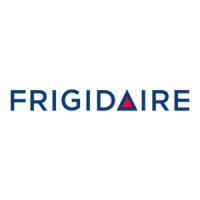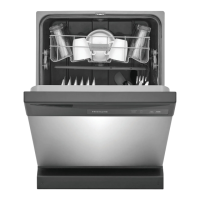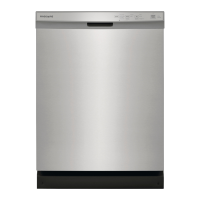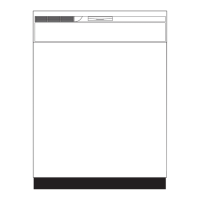Do you have a question about the Frigidaire FDPC4221AW and is the answer not in the manual?
Comprehensive safety guidelines for operating the dishwasher, covering electrical, operational, and usage precautions.
Explanation of typical sounds the dishwasher makes during operation, highlighting its quietness.
Step-by-step instructions for initial setup and operation of the dishwasher.
Details on available wash cycles and their characteristics, including time and water usage.
Explanation of Heat Dry and Air Dry options and their impact on drying performance and energy use.
Instructions for canceling cycles, locking controls for child safety, and status indicator lights.
Details on Heavy Wash, Normal Wash, and Recommended Cycle for optimal dishwashing performance.
Guidelines for scraping, rinsing, and preparing dishes before loading into the dishwasher.
Instructions for correctly placing cups, glasses, and small items on the upper rack for optimal cleaning.
Guidance on arranging plates, bowls, and cookware on the lower rack to ensure proper cleaning and spray arm clearance.
Best practices for loading silverware to maximize washability and prevent damage to items or the dishwasher.
Procedure for adding or removing dishes after the wash cycle has started without disrupting the process.
Instructions on how to properly fill the detergent dispenser cups for effective cleaning.
Guidance on how much detergent to use based on water hardness and cycle selection.
Explanation of rinse aid's role in improving drying, reducing spots, and its dispenser mechanism.
Essential water pressure and temperature guidelines for optimal dishwasher performance.
Step-by-step instructions for emptying and cleaning the glass trap and filter system.
Guidance on cleaning the dishwasher interior, tub gasket, and overfill protector.
Instructions for checking and cleaning the external drain air gap for proper drainage.
Instructions for winterizing the dishwasher to protect it from freezing in unheated areas.
A guide to common dishwasher problems and their potential solutions before calling for service.
Solutions for issues like food soils left on dishes and dishes not drying properly.
Tips for addressing glassware spotting or cloudiness, often related to water hardness and detergent use.
Advice on preventing dishware chipping and addressing stains or discoloration on dishes and utensils.
Troubleshooting steps for when the dishwasher fails to fill or exhibits leaks.
Information about the expected operating sounds of the dishwasher during various cycles.
Solutions for issues such as the dishwasher not running, not draining, or taking too long to complete a cycle.
Tips for eliminating odors, preventing tub stains, and addressing issues with opening the door during a cycle.
A detailed procedure using vinegar to remove hard water spots and film from the dishwasher interior.
List of conditions and situations not covered by the appliance's limited warranty.
Details on implied warranties, limitations of remedies, and consumer legal rights.
Information on how to contact Electrolux for warranty service and support within the USA and Canada.
Comprehensive safety guidelines for operating the dishwasher, covering electrical, operational, and usage precautions.
Explanation of typical sounds the dishwasher makes during operation, highlighting its quietness.
Step-by-step instructions for initial setup and operation of the dishwasher.
Details on available wash cycles and their characteristics, including time and water usage.
Explanation of Heat Dry and Air Dry options and their impact on drying performance and energy use.
Instructions for canceling cycles, locking controls for child safety, and status indicator lights.
Details on Heavy Wash, Normal Wash, and Recommended Cycle for optimal dishwashing performance.
Guidelines for scraping, rinsing, and preparing dishes before loading into the dishwasher.
Instructions for correctly placing cups, glasses, and small items on the upper rack for optimal cleaning.
Guidance on arranging plates, bowls, and cookware on the lower rack to ensure proper cleaning and spray arm clearance.
Best practices for loading silverware to maximize washability and prevent damage to items or the dishwasher.
Procedure for adding or removing dishes after the wash cycle has started without disrupting the process.
Instructions on how to properly fill the detergent dispenser cups for effective cleaning.
Guidance on how much detergent to use based on water hardness and cycle selection.
Explanation of rinse aid's role in improving drying, reducing spots, and its dispenser mechanism.
Essential water pressure and temperature guidelines for optimal dishwasher performance.
Step-by-step instructions for emptying and cleaning the glass trap and filter system.
Guidance on cleaning the dishwasher interior, tub gasket, and overfill protector.
Instructions for checking and cleaning the external drain air gap for proper drainage.
Instructions for winterizing the dishwasher to protect it from freezing in unheated areas.
A guide to common dishwasher problems and their potential solutions before calling for service.
Solutions for issues like food soils left on dishes and dishes not drying properly.
Tips for addressing glassware spotting or cloudiness, often related to water hardness and detergent use.
Advice on preventing dishware chipping and addressing stains or discoloration on dishes and utensils.
Troubleshooting steps for when the dishwasher fails to fill or exhibits leaks.
Information about the expected operating sounds of the dishwasher during various cycles.
Solutions for issues such as the dishwasher not running, not draining, or taking too long to complete a cycle.
Tips for eliminating odors, preventing tub stains, and addressing issues with opening the door during a cycle.
A detailed procedure using vinegar to remove hard water spots and film from the dishwasher interior.
List of conditions and situations not covered by the appliance's limited warranty.
Details on implied warranties, limitations of remedies, and consumer legal rights.
Information on how to contact Electrolux for warranty service and support within the USA and Canada.
This document is a Use & Care Manual for a Frigidaire dishwasher, providing comprehensive instructions for its operation, maintenance, and troubleshooting. The dishwasher is designed to clean dishes by spraying a mixture of hot water and detergent through spray arms against soiled surfaces. It operates by filling with water, pumping it through the spray arms, and filtering out soil particles before draining. This process repeats multiple times during a cycle, with the number of water fills varying based on the selected cycle.
The Frigidaire dishwasher offers various wash cycles and options to accommodate different cleaning needs. The core function is to efficiently clean and dry dishware, pots, pans, and silverware. It utilizes energy-efficient motors for both washing and draining. The Precision Direct Wash System ensures thorough cleaning, with water circulating through lower and upper spray arms. An automatic sensor checks incoming water temperature, and if it's not hot enough, the cycle length is adjusted to ensure proper heating for optimal detergent activation and soil removal.
The manual also includes extensive troubleshooting tips for common issues such as food soils left on dishes, dishes not drying, glassware/flatware spotting or cloudiness, chipped dishware, detergent left in cups, vapor at vent, unusual sounds, water in the bottom of the tub, leaks, dishwasher not filling, dishwasher not draining, long cycle times, and odors. These tips help users identify and resolve problems that are not due to defective workmanship or materials.
| Style | built in |
|---|---|
| Color | white |
| Load Capacity | 12 place settings |
| Number of Cycles | 2 |
| Number of Options | 1 |
| Drying Type | static dry |
| Noise level | 62 db |
| Control Type | gem k4 tower; touchpad |
| Delay Start | no |
| Child Lock | yes |
| Spray Arms | 2 |
| Water Filter | yes; plastic |
| Water Softener | no |
| Food Disposer | filtration; yes; stainless steel |
| Sanitize Settings | no |
| Wi-Fi | no |
| Smart Home | no |
| Remote Control | no |
| Water Consumption Per Cycle | 5 gallon max. |
| Voltage | 120 volts |
| Current | 10 |
| Depth | 25 inch |
|---|---|
| Height | 35 inch |
| Width | 24 inch |
| Net Weight | 56 lbs. |












